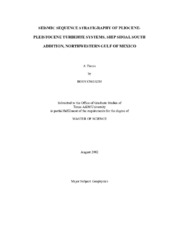| dc.description.abstract | During the Late Pliocene to Middle Pleistocene Ages, sediments of the study area were deposited in the intra-slope salt withdrawal basin where sand-prone sediments deposited as turbidite lobes and channel fills are the main reservoirs of the Northern Gulf of Mexico. The main purpose of this study was to identify and characterize these sand-prone sediments. Sequence stratigraphic analysis of well logs, biostratigraphic data, and 3-D seismic data provided a chronostratigraphic framework of the study area, within which seismic facies analysis was carried out. Each sequence was subdivided into separate seismic bodies characterized by specific amplitude, coherence of reflectors, and shape of reflectors. The descriptions of each seismic facies combined with well logs were compared with turbidite facies models to infer their geological information. Five turbidite elements were identified: depositional channel fills and overbank deposits, erosional channel fills, turbidite lobes, mud turbidite fills and sheets and hemipelagic and pelagic drapes. Depositional channel fills are usually deposited in lower parts of interpreted sequences, surrounded by shale-prone overbank deposits. The lateral variation of these turbidite elements was revealed by horizon slices, in which depositional channels are generally trending NE-SW or NNE-SSW with elongated sinuous forms. Well logs indicate that depositional channel fills usually consist of bell or cylinder type sand-prone sediments. Turbidite lobe was found only in the 1.1-0.8 Ma sequence, in which it laps out onto the underlying sequence boundary and shows high-amplitude and a high-coherence of mound shape. This facies is interpreted as sand-prone, but wells available penetrated only the marginal parts of this facies and showed poor reservoir qualities. Horizon slices could partly reveal its lapout boundary due to the limitation of vertical seismic resolution. Mud turbidite fills and sheets are the most dominant turbidite facies, which usually occurred in the upper parts of sequences and overlain by hemipelagic and pelagic drapes. Hemipelagic and pelagic drapes were deposited very widely, wrapping down the previous topography with consistent thickness throughout the basin. Erosional channel was observed only in the 0.8-0.7 Ma sequence where it cut into the underlying sequence and was filled by shale-prone sediments. Depositional channel fills and turbidite lobes are the main reservoir facies in the study area. Seismic facies analysis using vertical seismic sections and horizon slices combined with lithology data made it possible to identify and systematically describe these sand prone turbidite elements in intra-slope salt withdrawal basin. | en |


